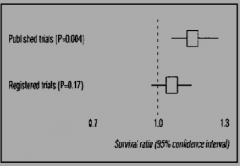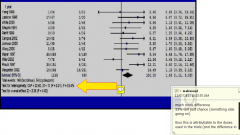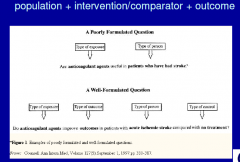![]()
![]()
![]()
Use LEFT and RIGHT arrow keys to navigate between flashcards;
Use UP and DOWN arrow keys to flip the card;
H to show hint;
A reads text to speech;
23 Cards in this Set
- Front
- Back
|
LOTS OF EXAM QUESTIONS ROM THIS LECTURE
|
check out slides
|
|
|
Dfferences between systematic review and meta analysis
|
SYSTEMATIC
• A thorough, defined literature search • An appraisal of the individual studies identified • A summary of these studies - NOT ALL SR include META-ANALYSIS Meta-Analysis • A statistical technique for combining data from multiple similar studies into a quantitative summary statistic (a weighted average of the individual study effects). • Allows formal testing of whether there are between study effects (heterogeneity) and why they might exist NOT ALL META-ANALYSIS FOLLOW Systematic review |
|
|
Role of meta anlysis
|
.
|
|
|
Forest Plot and its components
|
- dichotomous outcome
- from left to right 1. trial name 2. events in intervention 3. events in comparator 4. forest plot 5. weighting 6. RR (confidence interval) • Squares- represent the study’s estimate • Square size corresponds to the study’s weight • Lines through the squares estimate the CI • Vertical line is the “line of no effect” (no difference) • Diamond at the bottom represents the summary estimate • The tips of the diamond represent the CI of the summary estimate |
|
|
Reasons why we need systematic reviews
|
• Why we need reviews?
– To increase power to detect intervention effects • prevent delay in the introduction of effective therapies – To explore between study differences • Better select and individualise therapy – To cope with the amount of medical literature • Why systematic? – To obtain valid results – avoid random error and systematic error (bias) • We need summaries • Biomedical knowledge doubling rate is 19 years • 11,230 trials in nephrology alone POWER: eg one rare SE detected in a RCT and then added together through all the RCTs means more significance |
|
|
Search Techniques for systematic reviews
|
• Cochrane Database of Systematic
Reviews – www.cochrane.org • Medline – Meta analysis.pt OR – (Review.pt and MEDLINE.tw) |
|
|
Publication Bias
|

thus published literature can tend to over estimate benefit and under estimate harm
|
|
|
Heterogeneity
|

extent at which the results differ between results
between study effects - allows the opportunity to figure why there's heterogeneity and make us of it EXAMPLE: graft loss vs insulin requirement - the low dose showed best harm/benefit ratio and this came about from heterogenity in vaarious studies analysised + Tamoxifen and ER + cancer can also organise the results in duration to ID if the duration had an effect and the best duration therefore to treat for |
|
|
Publicaition Bias and Heterogeneity and their effect on validity of a systematic review
|
.
|
|
|
Weighted average
|
used in meta-analysis to ensure big studies dont dominate the results
|
|
|
Systematic steps in a systematic review
|
• Formulate the review question (PICO) &
write a protocol • Search for and include primary studies • Assess study quality • Extract data • Analyze data • Interpret results & write a report |
|
|
Difference between an ST and a normal review
|
an SR is more explicit and comprehensive
- SR only covers one aspect of the problem (INTERVENTION) while a normal review covers all aspects - an SR has a method section while a NR doesnt |
|
|
Narrative Reviews vs SR
|

– Good place to start when learning about a topic
– Subject to substantial biases and limitations so insufficient for clinical decision making • Systematic reviews – Not good for general summaries of clinical problems – Good place to look for specific clinical questions – Intervention, diagnosis, prognosis, aetiology |
|
|
Cumulative Meta-Anaylsis
|

- can allow to test for relative -ves of a drug (eg rofecoxib)
- allows to make a decision based on potential harm/benefit ratio |
|
|
Crtical Appraisal
|
• Did they say what they did and did they
do it right? – A well formulated question? (PICOT) – Appropriate inclusion criteria? – Comprehensive literature search? – Validity appraisal? – Heterogeneity of results? • Are reasons explored? |
|
|
Well built question?
|

|
|
|
Complete data?
|
• poor search
• Publication bias • Location biases (Foreign languages? ) • Duplication bias Not just medline |
|
|
Funnel plots
|

still some bias down here (it should be a triangle)
looks predominately for publication bias |
|
|
Duplication bias
|
beneficial effect made to look better through the same data set
so eg 4 trials have been published 134 times.... |
|
|
outcome reporting bias
|
not including relevant outcomes
- eg some trials dont report mortality as an outcome eg only 19 of 30 reported mortality in a graft rejection trials |
|
|
Exploring Heterogeneity
|
• Differences may be more revealing than similarities
• Are they solely the result of statistical variation? • Other possibilities: Different sample populations Different interventions Different comparisons Different measurements/outcomes Different timeframes |
|
|
Systematic reviews - Summary
|
• Allow for a more objective appraisal of the
evidence which may lead to resolution of uncertainty and disagreement • May reduce the probability of false negative results and thus prevent undue delays in the introduction of effective treatments into clinical practice • May allow testing of a priori hypotheses regarding treatment effects in subgroups of patients • Heterogeneity between study results may be explored and sometimes explained • Some quality assessment by the user is needed |
|
|
• Should systematic reviews should only be
done on placebo-controlled trials? |
no need to use gold standards at the time
|

